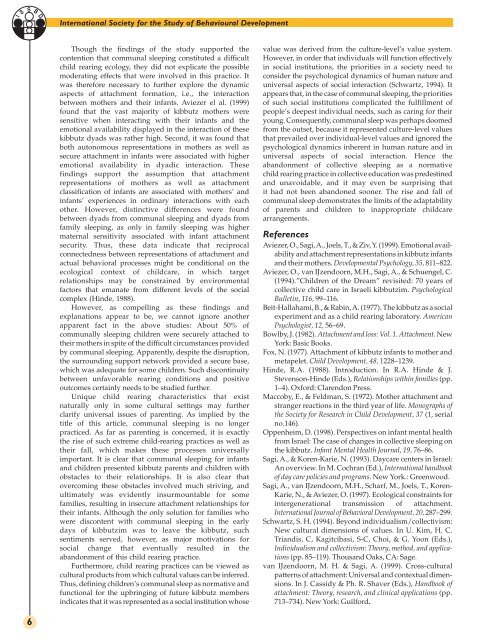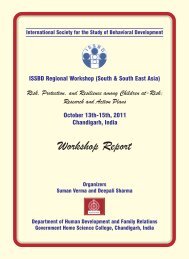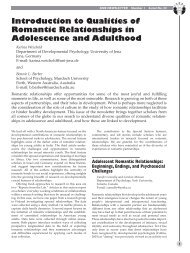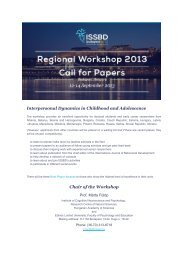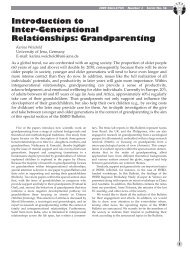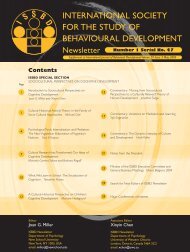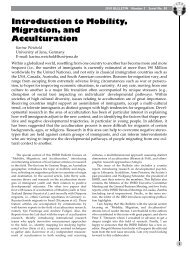Culture and Parenting - International Society for the Study of ...
Culture and Parenting - International Society for the Study of ...
Culture and Parenting - International Society for the Study of ...
You also want an ePaper? Increase the reach of your titles
YUMPU automatically turns print PDFs into web optimized ePapers that Google loves.
S<br />
I<br />
S<br />
B<br />
D<br />
<strong>International</strong> <strong>Society</strong> <strong>for</strong> <strong>the</strong> <strong>Study</strong> <strong>of</strong> Behavioural Development<br />
Though <strong>the</strong> findings <strong>of</strong> <strong>the</strong> study supported <strong>the</strong><br />
contention that communal sleeping constituted a difficult<br />
child rearing ecology, <strong>the</strong>y did not explicate <strong>the</strong> possible<br />
moderating effects that were involved in this practice. It<br />
was <strong>the</strong>re<strong>for</strong>e necessary to fur<strong>the</strong>r explore <strong>the</strong> dynamic<br />
aspects <strong>of</strong> attachment <strong>for</strong>mation, i.e., <strong>the</strong> interaction<br />
between mo<strong>the</strong>rs <strong>and</strong> <strong>the</strong>ir infants. Aviezer el al. (1999)<br />
found that <strong>the</strong> vast majority <strong>of</strong> kibbutz mo<strong>the</strong>rs were<br />
sensitive when interacting with <strong>the</strong>ir infants <strong>and</strong> <strong>the</strong><br />
emotional availability displayed in <strong>the</strong> interaction <strong>of</strong> <strong>the</strong>se<br />
kibbutz dyads was ra<strong>the</strong>r high. Second, it was found that<br />
both autonomous representations in mo<strong>the</strong>rs as well as<br />
secure attachment in infants were associated with higher<br />
emotional availability in dyadic interaction. These<br />
findings support <strong>the</strong> assumption that attachment<br />
representations <strong>of</strong> mo<strong>the</strong>rs as well as attachment<br />
classification <strong>of</strong> infants are associated with mo<strong>the</strong>rs’ <strong>and</strong><br />
infants’ experiences in ordinary interactions with each<br />
o<strong>the</strong>r. However, distinctive differences were found<br />
between dyads from communal sleeping <strong>and</strong> dyads from<br />
family sleeping, as only in family sleeping was higher<br />
maternal sensitivity associated with infant attachment<br />
security. Thus, <strong>the</strong>se data indicate that reciprocal<br />
connectedness between representations <strong>of</strong> attachment <strong>and</strong><br />
actual behavioral processes might be conditional on <strong>the</strong><br />
ecological context <strong>of</strong> childcare, in which target<br />
relationships may be constrained by environmental<br />
factors that emanate from different levels <strong>of</strong> <strong>the</strong> social<br />
complex (Hinde, 1988).<br />
However, as compelling as <strong>the</strong>se findings <strong>and</strong><br />
explanations appear to be, we cannot ignore ano<strong>the</strong>r<br />
apparent fact in <strong>the</strong> above studies: About 50% <strong>of</strong><br />
communally sleeping children were securely attached to<br />
<strong>the</strong>ir mo<strong>the</strong>rs in spite <strong>of</strong> <strong>the</strong> difficult circumstances provided<br />
by communal sleeping. Apparently, despite <strong>the</strong> disruption,<br />
<strong>the</strong> surrounding support network provided a secure base,<br />
which was adequate <strong>for</strong> some children. Such discontinuity<br />
between unfavorable rearing conditions <strong>and</strong> positive<br />
outcomes certainly needs to be studied fur<strong>the</strong>r.<br />
Unique child rearing characteristics that exist<br />
naturally only in some cultural settings may fur<strong>the</strong>r<br />
clarify universal issues <strong>of</strong> parenting. As implied by <strong>the</strong><br />
title <strong>of</strong> this article, communal sleeping is no longer<br />
practiced. As far as parenting is concerned, it is exactly<br />
<strong>the</strong> rise <strong>of</strong> such extreme child-rearing practices as well as<br />
<strong>the</strong>ir fall, which makes <strong>the</strong>se processes universally<br />
important. It is clear that communal sleeping <strong>for</strong> infants<br />
<strong>and</strong> children presented kibbutz parents <strong>and</strong> children with<br />
obstacles to <strong>the</strong>ir relationships. It is also clear that<br />
overcoming <strong>the</strong>se obstacles involved much striving, <strong>and</strong><br />
ultimately was evidently insurmountable <strong>for</strong> some<br />
families, resulting in insecure attachment relationships <strong>for</strong><br />
<strong>the</strong>ir infants. Although <strong>the</strong> only solution <strong>for</strong> families who<br />
were discontent with communal sleeping in <strong>the</strong> early<br />
days <strong>of</strong> kibbutzim was to leave <strong>the</strong> kibbutz, such<br />
sentiments served, however, as major motivations <strong>for</strong><br />
social change that eventually resulted in <strong>the</strong><br />
ab<strong>and</strong>onment <strong>of</strong> this child rearing practice.<br />
Fur<strong>the</strong>rmore, child rearing practices can be viewed as<br />
cultural products from which cultural values can be inferred.<br />
Thus, defining children’s communal sleep as normative <strong>and</strong><br />
functional <strong>for</strong> <strong>the</strong> upbringing <strong>of</strong> future kibbutz members<br />
indicates that it was represented as a social institution whose<br />
value was derived from <strong>the</strong> culture-level’s value system.<br />
However, in order that individuals will function effectively<br />
in social institutions, <strong>the</strong> priorities in a society need to<br />
consider <strong>the</strong> psychological dynamics <strong>of</strong> human nature <strong>and</strong><br />
universal aspects <strong>of</strong> social interaction (Schwartz, 1994). It<br />
appears that, in <strong>the</strong> case <strong>of</strong> communal sleeping, <strong>the</strong> priorities<br />
<strong>of</strong> such social institutions complicated <strong>the</strong> fulfillment <strong>of</strong><br />
people’s deepest individual needs, such as caring <strong>for</strong> <strong>the</strong>ir<br />
young. Consequently, communal sleep was perhaps doomed<br />
from <strong>the</strong> outset, because it represented culture-level values<br />
that prevailed over individual-level values <strong>and</strong> ignored <strong>the</strong><br />
psychological dynamics inherent in human nature <strong>and</strong> in<br />
universal aspects <strong>of</strong> social interaction. Hence <strong>the</strong><br />
ab<strong>and</strong>onment <strong>of</strong> collective sleeping as a normative<br />
child rearing practice in collective education was predestined<br />
<strong>and</strong> unavoidable, <strong>and</strong> it may even be surprising that<br />
it had not been ab<strong>and</strong>oned sooner. The rise <strong>and</strong> fall <strong>of</strong><br />
communal sleep demonstrates <strong>the</strong> limits <strong>of</strong> <strong>the</strong> adaptability<br />
<strong>of</strong> parents <strong>and</strong> children to inappropriate childcare<br />
arrangements.<br />
References<br />
Aviezer, O., Sagi, A., Joels, T., & Ziv, Y. (1999). Emotional availability<br />
<strong>and</strong> attachment representations in kibbutz infants<br />
<strong>and</strong> <strong>the</strong>ir mo<strong>the</strong>rs. Developmental Psychology, 35, 811–822.<br />
Aviezer, O., van IJzendoorn, M.H., Sagi, A., & Schuengel, C.<br />
(1994).”Children <strong>of</strong> <strong>the</strong> Dream” revisited: 70 years <strong>of</strong><br />
collective child care in Israeli kibbutzim. Psychological<br />
Bulletin, 116, 99–116.<br />
Beit-Hallahami, B., & Rabin, A. (1977). The kibbutz as a social<br />
experiment <strong>and</strong> as a child rearing laboratory. American<br />
Psychologist, 12, 56–69.<br />
Bowlby, J. (1982). Attachment <strong>and</strong> loss: Vol. 1. Attachment. New<br />
York: Basic Books.<br />
Fox, N. (1977). Attachment <strong>of</strong> kibbutz infants to mo<strong>the</strong>r <strong>and</strong><br />
metapelet. Child Development, 48, 1228–1239.<br />
Hinde, R.A. (1988). Introduction. In R.A. Hinde & J.<br />
Stevenson-Hinde (Eds.), Relationships within families (pp.<br />
1–4). Ox<strong>for</strong>d: Clarendon Press.<br />
Maccoby, E., & Feldman, S. (1972). Mo<strong>the</strong>r attachment <strong>and</strong><br />
stranger reactions in <strong>the</strong> third year <strong>of</strong> life. Monographs <strong>of</strong><br />
<strong>the</strong> <strong>Society</strong> <strong>for</strong> Research in Child Development, 37 (1, serial<br />
no.146).<br />
Oppenheim, D. (1998). Perspectives on infant mental health<br />
from Israel: The case <strong>of</strong> changes in collective sleeping on<br />
<strong>the</strong> kibbutz. Infant Mental Health Journal, 19, 76–86.<br />
Sagi, A., & Koren-Karie, N. (1993). Daycare centers in Israel:<br />
An overview. In M. Cochran (Ed.), <strong>International</strong> h<strong>and</strong>book<br />
<strong>of</strong> day care policies <strong>and</strong> programs. New York.: Greenwood.<br />
Sagi, A., van IJzendoorn, M.H., Scharf, M., Joels, T., Koren-<br />
Karie, N., & Aviezer, O. (1997). Ecological constraints <strong>for</strong><br />
intergenerational transmission <strong>of</strong> attachment.<br />
<strong>International</strong> Journal <strong>of</strong> Behavioral Development, 20, 287–299.<br />
Schwartz, S. H. (1994). Beyond individualism/collectivism:<br />
New cultural dimensions <strong>of</strong> values. In U. Kim, H. C.<br />
Tri<strong>and</strong>is, C, Kagitcibasi, S-C, Choi, & G. Yoon (Eds.),<br />
Individualism <strong>and</strong> collectivism: Theory, method, <strong>and</strong> applications<br />
(pp. 85–119). Thous<strong>and</strong> Oaks, CA: Sage.<br />
van IJzendoorn, M. H. & Sagi, A. (1999). Cross-cultural<br />
patterns <strong>of</strong> attachment: Universal <strong>and</strong> contextual dimensions.<br />
In J. Cassidy & Ph. R. Shaver (Eds.), H<strong>and</strong>book <strong>of</strong><br />
attachment: Theory, research, <strong>and</strong> clinical applications (pp.<br />
713–734). New York: Guil<strong>for</strong>d.<br />
6


